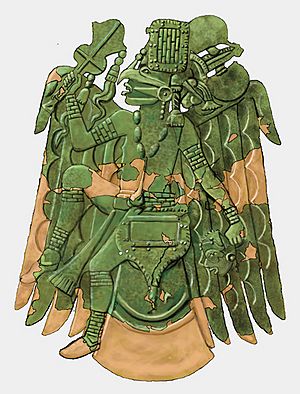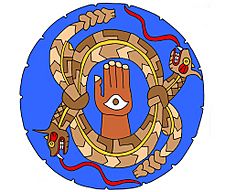Creek mythology facts for kids
The Creek people are also known as the Muscogee (or Mvskoke). They are a group of Native American people who originally lived in the southeastern United States. Today, many Muscogee people live in Oklahoma, Alabama, Georgia, and Florida. Their language, called Mvskoke, is part of the Muskogean language family. The Seminole people are closely related to the Muscogee and speak a similar language. The Muscogee were once known as one of the "Five Civilized Tribes." After a conflict called the Creek War, some Muscogee people moved to Florida and became the Seminole.
History of the Muscogee People
The Muscogee people today are likely descendants of the ancient Mississippian culture. These people lived along the Tennessee River in what is now Tennessee and Alabama.
The Muscogee were not just one single tribe. They were a group of many independent villages. These villages were located in river valleys across what is now Tennessee, Georgia, and Alabama. Different groups within the Muscogee spoke various languages, like Hitchiti, Alabama, and Coushatta.
British traders from South Carolina first called the people living along the Ocmulgee and Oconee Rivers "Creek Indians." Eventually, this name was used for all the different Native American towns in the area. These towns were often divided into two main groups:
- Lower Towns: These were closer to the Georgia frontier, along rivers like the Chattahoochee and Flint. Important Lower Towns included Coweta and Cusseta.
- Upper Towns: These were located in the Alabama River Valley.
Even today, Cusseta and Coweta are two of the most important towns for the Muscogee Nation. They are traditionally seen as the first members of the Muscogee Nation.
Muscogee Creation Story
The Muscogee people have a special story about how the world began. They believed that at first, the entire world was covered in water. The only dry land was a hill called Nunne Chaha.
On this hill lived Hesaketvmese, who they called the "Master of Breath." He was a powerful sun god, also known as "the one who is sitting above us." The Master of Breath created the first humans from the clay found on Nunne Chaha hill.
Before the world was created, there was only confusion and strange creatures in the underworld. The Master of Breath brought order by creating Brother Moon and Sister Sun. He also created the four directions to hold up the world.
The first people were believed to be the children of Sister Sun and a special being called the Horned Serpent (Sint Holo). These first two Muscogee people were named Lucky Hunter and Corn Woman. Their names show their important roles in Muscogee society: hunting for food and growing corn.
See also
 In Spanish: Mitología creek para niños
In Spanish: Mitología creek para niños



